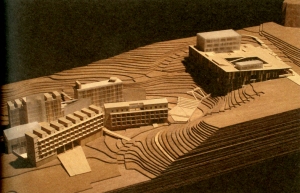Structuring Emptiness presents two Korean architects, Seung H-Sang and Min Hyun-Sik. They both became famous as members of the 4.3 Group who published a manifesto about 20 years ago on the future of Korean architecture following the heritage of Kim Soo Geun (father of Korean modern architecture). They now have their own respective offices, but they share the same belief in the architectural concept of emptiness.

According to them, empty space is unique in that it offers extraordinary experiences in the context of ordinary. It mobilizes all our senses and provides room for sound, weather, seasons, nature to take place within. [p.41] They apply and adapt that notion to the development of the buildings described in the book mainly through the use of exterior courtyards.
Calling themselves “Reflective Moderns”, both architects do not consider modern architectural principals as a solution, but use some as design bases. Therefore, while retaining the global language of modern architecture, the two architects recognize the main flaws and adapt their design to local and contextual circumstances: to the landscape and to its surroundings.
Despite their common interest in land, context, community and simple, articulated spaces, each architect is unique. Min Hyun-Sik is highly rational and systematic in his compositions, while Seung H-Sang shows interest in variations, boundaries and creating dynamic urban-like spaces. [p.59] These defining elements are presented in their respective projects and detailed in the book.
This book focuses on two projects that place the architects in direct relation to each other; on adjacent sites in a valley on the campus of Daejeon University. The former did the Hyehwa Culture Center, while the latter designed the student dormitory. It provided the perfect comparative ground for their respective takes on a common conceptual idea (emptiness), resulting in an exhibition on the subject as well as this subsequent book. This book is well structured in 5 different parts : the reason for publishing the book, a short presentation by Khang Hyuk of the architects, the 2 projects and a concluding interview done by Khang Hyuk with both architects.

Model of the projects [p.17]
Presented in a clear and easily understandable way by Khang Hyunk, the introduction of both architects as well as their shared conceptual belief in emptiness covers all aspects of the topic, from architects’ past years up to their exhibition and the evolution of their conceptual discourse. Though generous in details and explanations, a more nuanced approach would have been more appreciated than the constant approval of the architects’ positions.
The description of the buildings is presented by the respective architects in a neutral, descriptive way. It serves as a good follow up to their introduction and adds information/details relevant to each building specifically. Though generally not explicitely stated in the architect’s writings, the relationship between the conceptual ideas of emptiness presented by Khang Hyuk and the buildings is easy to understand.
For instance, in the Hyehwa Culture Center, by Seung H-Sang, the huge (62m x 54m) open deck nestled in the middle of the building speaks of the architect’s ideas of dynamic urban like spaces. Easily appropriable thanks to its good articulation within the building, it looks like a smaller version of Dominique Perreault’s design for the ECC at Ewha Womans University.

Hyehwa Culture Center [p.74]

Open deck [p.90]
For the student’s dormitory, by Min Hyun-Sik, a coherent and easy to read succession of spaces is created, where the corridors are used as a transition area between public (inner court) and private spaces (students’ rooms). This relationship between interior and exterior spaces talks of Min Hyun-Sik’s idea of exteriorized interior/interiorized exterior. [p.117-119]

Student dormitory with the inner court in between [p.123]

Student room [p.141]
The last section, the interview with the two architects, unfortunately does not add anything new to what as already been said in the previous sections. Not only that, the interviewer is completely sold to the two architects, doing nothing more than merely repeating, agreeing or rephrasing what the interviewees are telling him. A debate of ideas around the projects and the theories of space/emptiness would have been a great addition to the book. In other words, something that could help to better understand the topic, bring it forward or open up on another architectural issue Korea is facing at the moment.
Structuring Emptiness is a good introduction to both Seung H.-Sang and Min Hyun-Sik’s architectural ideas and practice. It stands as one of the few good and affordable (about 20 000 won – 18-20$) book on Korean contemporary architecture. The first thing that hits when going through the pages of this book is the quality of its production. It is easy to read, and the descriptions are adequate. Too often are we met with ill-translated books on Korean architecture that does little to no justice to their subjects. Hence, it is easy to look over the few little mistakes that are spread out here and there in the book. Another good aspect is the generous amount of supporting images. There are a lot of pictures, plans, elevations and sections for both projects. It becomes easy to reference textual ideas with pictures or drawings.
To conclude, it is definitely worth checking it out and, as Min Hyun-Sik wrote himself as a reason to publish this book: “It is my hope that this book will become a small but pleasant addition to our collective endeavour in promoting our architectural culture.”[p.15] Exactly what this website is meant to do as well!

Any idea where I can get a copy of this book? I’m having trouble tracking down the English version. Thanks! –Hallie
Actually, there is no English only version of this book. The book is written in both Korean and English. I bought my copy at Bandi & Luni’s Bookstore and I know that Kyobo Bookstore sell it as well. If you live outside of Korea, you can order it online through their websites (http://www.bandinlunis.com/ ; http://www.kyobobook.co.kr/ – 비움의 구축 as search topic). Good luck!
– David Martin